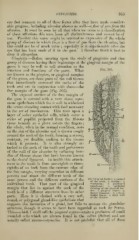Page 945 - My FlipBook
P. 945
GINGIVITIS. ; — 955
one fact common to all of these forms after they have made consider-
able progress, including; alveolar abscess as well a flow of pus from the
alveolus. It must be seen by all that when we come to a classification
of these affections this term loses all distinctiveness and cannot be of
use. Possibly this name might be retained as expressive of the whole
group of diseases in which there is a flow of pus from the alveolus, but
this could not be of much value ; especially is it objectionable after the
use that has been made of it in the past. I therefore think it best to
drop it altogether.
Cringivitis.—Before entering upon the study of gingivitis and that
group of diseases having their beginnings at the gingival margin of the
gums it may be well to call attention to the
structure and functions of the pai'ts. What Fig. 505.
are known as the gingivce, or gingival margins
of the gums, are those parts of the soft tissues
that immediately surround the necks of the
teeth and are in conjunction with them—the
free margin of the gum (Fig. 505).
The exposed surface of the free margin of
the gum is covered with a very dense squa-
mous epithelium which fits it well to withstand
the severe abrading contact with food necessary
in the act of mastication. This rests upon a
layer of softer epithelial cells, which cover a
series of papillae projected from the fibrous
tissue beneath as a glove covers the fingers
the whole, M'hen in the normal condition, rests
on the rim of the alveolus and is drawn snugly
around the neck of the tooth, forming a strong,
resistant, yet flexible, cushion to the tissues
which it protects. It is also strongly at-
tached to the neck of the tooth and periosteum
of the wall of the alveolus by radiating bun-
dles of fibrous tissue that have become known
as the dental ligament. In health this attach-
ment to the tooth is from one-eighth to three-
eighths of an inch from the extreme edge of
the free margin, varying somewhat in different
persons and about the different teeth of the
The Gingival Border : a, enamel
same person and the different surfaces of the
of the tooth ; 6, dentine : c.
individual teeth. That part of the gingival eeraentum; d, peridentil
membrane; e, epithelial
margin that lies in against the neck of the covering of the gingival bor-
der : /, gingival organ ; tooth is of a different structure from its other dental ligament; fi, subepi-
parts. Here it is clothed w'ith a very soft, thelial tissue ; i, bony wall
of the alveolus.
round, or ])olygonal gland-like epithelium that
suggests the formation of a gland, but fails to assume the glandular
structure, though it seems to have been regarded as such by Serres.
This—which I shall call the gingival organ—emits a profusion of small
rounded cells which are always found in the saliva (Salter) and are
usually called mucus-corpuscles. It is not probable that all of these


